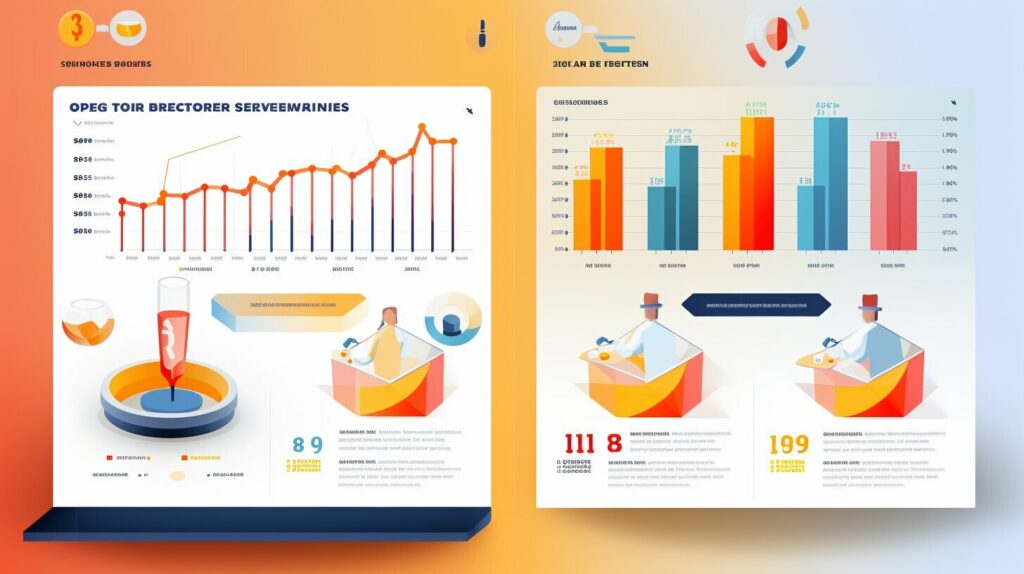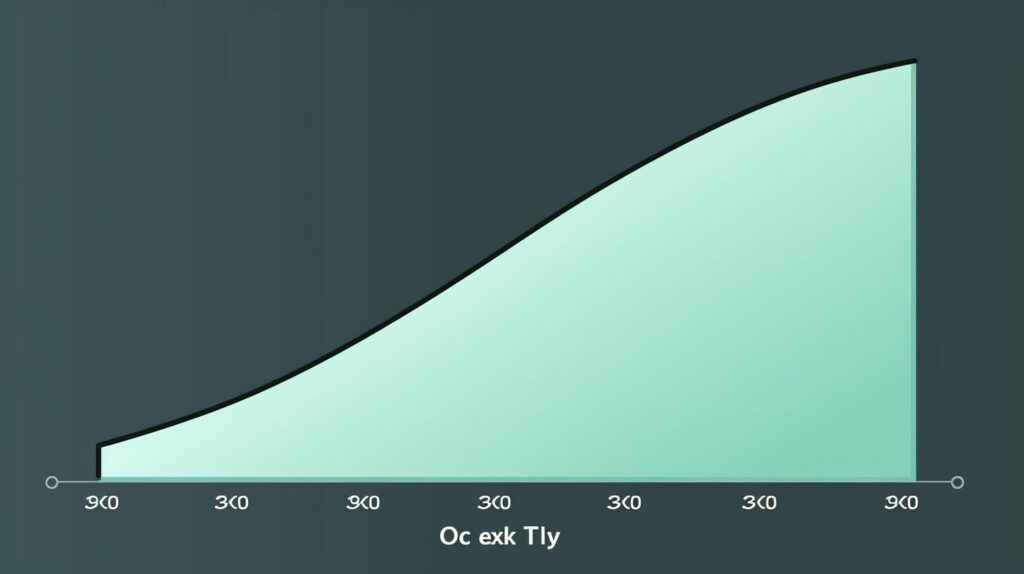Conversion Rate Optimization (CRO) is a vital process for businesses looking to maximize their potential and achieve success in the digital landscape. By implementing effective strategies, you can increase your conversion rates and generate more leads and revenue. In this section, we will delve into the concept of CRO and its impact on your online performance.
Conversion Rate Optimization (CRO) is the process of increasing the percentage of users or website visitors who complete a specific action to generate more leads and increase revenue. A high conversion rate indicates a well-designed and appealing website, while a low conversion rate can be attributed to factors such as slow load times or ineffective copy. The average conversion rate varies by industry, but CRO is important for any business online to convert visitors into qualified leads and customers. To calculate conversion rate, divide the number of conversions by the number of visitors and multiply by 100. CRO can be integrated with search engine optimization (SEO) to improve website visibility and functionality. Important areas of a website that can benefit from CRO include the homepage, pricing page, blog, and landing pages. A CRO strategy involves conducting A/B testing and analyzing data to optimize calls to action, landing page design, website copy, navigation and site structure, forms, and page speed. The benefits of CRO include improving marketing return on investment and overall revenue for the business.
Key Takeaways:
- CRO is essential for businesses to maximize their potential online.
- A well-designed and appealing website can lead to higher conversion rates.
- Calculating conversion rate helps measure the effectiveness of your website.
- Integrating CRO with SEO can enhance website visibility and functionality.
- Optimizing key areas of your website, such as the homepage and landing pages, can increase conversions.
Understanding Conversion Rate Optimization
Conversion Rate Optimization (CRO) is the practice of enhancing your website to increase the percentage of visitors who take desired actions, ultimately improving your conversion rates. It involves analyzing user behavior, identifying barriers to conversion, and implementing effective strategies to overcome them. By optimizing your website’s design, content, and functionality, you can create a seamless user experience that encourages visitors to take action.
One of the key aspects of CRO is understanding your target audience and their preferences. By conducting thorough research, you can gain insights into their needs, motivations, and pain points. This information allows you to tailor your website to meet their specific requirements, making it more appealing and persuasive.
Another important element of CRO is testing and experimentation. A/B testing allows you to compare different versions of your website or landing page to determine which one performs better. By making incremental changes and analyzing the results, you can gradually optimize your conversion rates over time.
“Conversion Rate Optimization is not a one-time effort, but an ongoing process of refinement and improvement.”
The Benefits of CRO
- Improved User Experience: CRO ensures that your website is user-friendly, intuitive, and enjoyable to navigate, which leads to increased engagement and conversions.
- Increased Conversion Rates: By removing friction points and optimizing your website’s design and content, you can significantly boost your conversion rates and generate more leads.
- Higher Return on Investment (ROI): CRO allows you to make the most of your existing traffic by maximizing the number of conversions. This results in a higher ROI for your marketing efforts.
- Data-Driven Decision Making: Through rigorous analysis and testing, CRO provides valuable insights into user behavior and preferences. This data-driven approach enables you to make informed decisions and continuously improve your website’s performance.
Overall, Conversion Rate Optimization is a crucial practice for businesses looking to thrive online. By implementing effective strategies, understanding your audience, and continuously testing and refining your website, you can achieve higher conversion rates, increase revenue, and stay ahead of the competition.
| Conversion Rate Optimization | Benefits |
|---|---|
| Improved User Experience | Increased engagement and conversions |
| Increased Conversion Rates | Generate more leads and revenue |
| Higher Return on Investment (ROI) | Maximize conversions and ROI |
| Data-Driven Decision Making | Informed decisions and continuous improvement |
Key Metrics and Analysis in Conversion Rate Optimization
To effectively optimize your conversion rates, it is crucial to track and analyze key metrics that provide insights into your website’s performance. By understanding these metrics, you can identify areas for improvement and make data-driven decisions to enhance your conversion rate.
One key metric to monitor is the conversion rate itself. This metric measures the percentage of website visitors who take a desired action, such as making a purchase or filling out a form. Calculating your conversion rate involves dividing the number of conversions by the number of visitors and multiplying by 100. Tracking your conversion rate over time allows you to gauge the effectiveness of your optimization efforts.
Another important metric is the bounce rate, which indicates the percentage of visitors who leave your website after viewing only one page. A high bounce rate may suggest that visitors are not finding what they’re looking for or that your website is not engaging enough. By analyzing the bounce rate, you can identify pages that need improvement and make adjustments to keep visitors on your site longer.
Additionally, analyzing the click-through rate (CTR) can provide insights into the effectiveness of your calls to action and website navigation. The CTR measures the percentage of visitors who click on a specific element, such as a button or link. Tracking the CTR helps you identify elements that are generating engagement and those that may need optimization.
Conversion Rate Metrics
To summarize, here are the key metrics you should track for effective Conversion Rate Optimization:
- Conversion rate: Measures the percentage of visitors who complete a desired action.
- Bounce rate: Indicates the percentage of visitors who leave after viewing only one page.
- Click-through rate (CTR): Measures the percentage of visitors who click on a specific element.
By analyzing and monitoring these metrics, you can gain valuable insights into your website’s performance and take the necessary steps to optimize your conversion rate. Remember, Conversion Rate Optimization is an ongoing process, and continuously evaluating and adjusting your strategies based on these metrics will help you achieve your business goals.
| Metric | Definition |
|---|---|
| Conversion Rate | The percentage of visitors who complete a desired action. |
| Bounce Rate | The percentage of visitors who leave after viewing only one page. |
| Click-through Rate (CTR) | The percentage of visitors who click on a specific element. |
Tracking and analyzing key conversion rate metrics are essential for effective Conversion Rate Optimization. By understanding these metrics, you can identify areas for improvement and make data-driven decisions to enhance your website’s performance and increase your conversion rates.
Strategies for Boosting Conversion Rates
Implementing effective strategies is crucial for boosting your conversion rates and achieving your business goals. By optimizing your website and improving user experience, you can increase the likelihood of visitors taking action and converting into customers. Here are some strategies to help you optimize your website for maximum conversions:
1. Optimize Your Calls to Action
Your calls to action (CTAs) play a pivotal role in driving conversions. Make sure your CTAs are clear, compelling, and prominently displayed on your website. Use action-oriented language and create a sense of urgency to encourage visitors to take immediate action. Test different colors, sizes, and placements for your CTAs to identify the most effective combination.
2. Improve Your Landing Page Design
A well-designed landing page is essential for capturing visitor’s attention and convincing them to convert. Ensure your landing pages are visually appealing, easy to navigate, and mobile-friendly. Use concise and persuasive copy, relevant visuals, and a clean layout to convey your message effectively. Test different layouts, headlines, and forms to optimize your landing page for conversions.
3. Enhance User Experience with Website Optimization
A positive user experience is crucial for increasing conversion rates. Optimize your website’s speed, responsiveness, and overall functionality to ensure a seamless browsing experience. Streamline your navigation, simplify your checkout process, and make it easy for visitors to find what they’re looking for. Use clear headings, bullet points, and visual aids to present information in a user-friendly manner.
| Optimization Techniques | Description |
|---|---|
| Homepage Optimization | Optimize your homepage to capture visitors’ attention and guide them towards conversion. Use compelling headlines, relevant visuals, and concise copy to convey your value proposition. |
| Pricing Page Optimization | Make your pricing page informative and persuasive. Clearly display pricing options, highlight key features, and use social proof to build trust. |
| Blog Optimization | Optimize your blog for conversions by including relevant CTAs within your blog posts. Provide valuable content that addresses your audience’s pain points and encourages them to take action. |
| Landing Page Optimization | Create dedicated landing pages for your marketing campaigns. Customize each landing page to match the messaging of your campaigns and optimize them for conversions. |
By implementing these strategies and continuously testing and analyzing your website’s performance, you can optimize your conversion rates and drive more qualified leads. Remember to always prioritize your target audience’s needs and preferences to create a seamless and persuasive user experience.

Website optimization is an integral part of Conversion Rate Optimization, as it ensures that your website is user-friendly, engaging, and meets the expectations of your target audience. By optimizing key areas of your website, you can enhance the overall user experience and increase the likelihood of conversions.
One essential aspect of website optimization is ensuring that your site loads quickly. Research shows that users tend to abandon websites that take too long to load, leading to a higher bounce rate and lower conversion rates. By optimizing your website’s speed, you can improve user experience and reduce the risk of visitors leaving before taking the desired action.
Another crucial element of website optimization is responsive design. With the increasing use of mobile devices, it is essential to ensure that your website is fully responsive and seamlessly adapts to different screen sizes. A responsive website design not only provides a better user experience but also improves your website’s search engine rankings, driving more organic traffic and potential conversions.

In addition, optimizing your website’s navigation and site structure can make it easier for users to find the information they are looking for. Clear and intuitive navigation helps guide visitors through your website, increasing their engagement and reducing the likelihood of them leaving before completing a conversion.
Key Areas for Website Optimization
| Key Areas | Optimization Techniques |
|---|---|
| Homepage | Clear messaging, compelling CTA, relevant content |
| Pricing Page | Transparent pricing, comparison options, persuasive copy |
| Blog | High-quality content, easy navigation, social sharing buttons |
| Landing Pages | Compelling headlines, persuasive copy, optimized forms |
By optimizing these key areas, you can create a seamless user experience that encourages visitors to take the desired action, ultimately leading to increased conversions and business growth.
A/B Testing and Data Analysis in CRO
A/B testing and data analysis are instrumental in understanding user behavior, identifying optimization opportunities, and driving continuous improvements in your conversion rates. With A/B testing, you can compare two variations of a website element or page to determine which one performs better in terms of conversion rate. By splitting your traffic and randomly assigning visitors to either the control group or the variant group, you can gather valuable data to guide your optimization efforts.
When conducting A/B tests, it’s crucial to define clear goals and metrics to measure success. This could involve tracking click-through rates, form completions, or purchases. By analyzing the results, you can determine which variation resonates better with your audience and leads to higher conversion rates. It’s important to note that A/B testing should be done incrementally, making small changes to isolate the impact of each variation.
Data analysis plays a pivotal role in extracting insights from A/B test results. By diving deep into the data, you can uncover patterns and trends that provide valuable information about user preferences and behavior. Tools like Google Analytics can help you track and analyze user interactions, such as bounce rates, session duration, and conversion funnels. This data can inform your decision-making process and guide future optimization strategies.
To maximize the effectiveness of A/B testing and data analysis, it’s essential to adopt a systematic approach. Start by identifying areas of your website that could benefit from optimization, such as your call-to-action buttons, headline copy, or form fields. Develop hypotheses based on your understanding of user behavior and design A/B tests accordingly. Once you have collected sufficient data, analyze the results, draw insights, and implement the winning variations to continuously improve your conversion rates.

- Identify key areas of your website that could benefit from optimization.
- Create hypotheses for A/B testing based on user behavior and goals.
- Split your traffic and randomly assign visitors to control and variant groups.
- Define clear goals and metrics to measure success.
- Analyze the results of your A/B tests to uncover insights.
- Implement the winning variations to continuously improve your conversion rates.
- Regularly track and analyze user interactions using tools like Google Analytics.
By leveraging A/B testing and data analysis, you can make data-driven decisions to optimize your website for higher conversion rates. Continuously testing and analyzing different variations will enable you to understand your audience better, identify optimization opportunities, and ultimately drive meaningful improvements in your business’s online performance.
| Key Benefits of A/B Testing and Data Analysis in CRO |
|---|
| Identify the most effective variations for increasing conversion rates |
| Gain insights into user behavior and preferences |
| Make informed decisions based on data rather than assumptions |
| Optimize your website for better user experience and engagement |
| Drive continuous improvements in ROI and overall revenue |
Integrating CRO with SEO for Enhanced Results
Integration of Conversion Rate Optimization (CRO) with Search Engine Optimization (SEO) allows you to optimize both your website’s visibility and user experience simultaneously. By aligning these two strategies, you can create a seamless online presence that not only attracts visitors but also converts them into customers.
When implementing CRO, it’s crucial to consider SEO principles to ensure that your website is easily discoverable by search engines. By optimizing your website’s structure, meta tags, and keywords, you can improve organic rankings and drive more targeted traffic to your site. This increased visibility provides a greater opportunity for conversions.
Furthermore, CRO techniques can also enhance the user experience, leading to improved engagement and conversions. By analyzing user behavior through A/B testing and data analysis, you can identify pain points in the user journey and make data-driven adjustments. This includes optimizing calls to action, improving landing page design, and enhancing website copy and navigation.
| Benefits of Integrating CRO with SEO | Benefits of Integrating CRO with SEO |
|---|---|
| – Improved website visibility | – Enhanced user experience |
| – Increased organic traffic | – Higher engagement |
| – Better targeting of keywords | – Increased conversions |
“Integrating CRO and SEO allows you to create a holistic approach to online optimization, where your website not only ranks well in search engine results but also converts visitors into valuable customers.”
To effectively integrate CRO with SEO, it’s essential to continuously analyze and refine your strategies. Regularly monitor your conversion rates, website analytics, and keyword performance to identify areas for improvement. Implementing an iterative optimization process will help you stay ahead of the competition and maximize your online success.

By leveraging the power of both Conversion Rate Optimization and Search Engine Optimization, you can drive meaningful results for your online business. Remember to optimize key areas of your website, conduct A/B tests, and analyze data to make informed decisions. With an integrated approach, you can unlock the full potential of your website, attract the right audience, and achieve your business goals.
Optimizing Key Areas for Conversion Rates
To achieve optimal conversion rates, it is important to focus on key areas of your website that play a crucial role in attracting and converting visitors. By optimizing these areas, you can maximize your chances of converting leads into customers. Let’s explore the key areas that can greatly benefit from Conversion Rate Optimization:
1. Homepage Optimization
Your homepage is the first impression visitors have of your website, so it’s essential to make it visually appealing and user-friendly. Optimize your homepage by clearly communicating your value proposition, showcasing your unique selling points, and including a prominent and compelling call to action (CTA). Make sure your CTA stands out and directs visitors to the next step in their customer journey.
2. Pricing Page Optimization
Your pricing page is where visitors evaluate the cost and value of your products or services. Keep your pricing page simple, transparent, and easy to understand. Highlight the most popular pricing plans or options and include testimonials or case studies that demonstrate the value of your offerings. Make it easy for visitors to select a plan and proceed to the checkout process.
3. Blog Optimization
A well-optimized blog can attract a steady stream of organic traffic and engage visitors with valuable content. Optimize your blog by using relevant keywords, crafting compelling headlines, and incorporating internal links to guide visitors to other areas of your website. Format your blog posts with clear headings, bullet points, and images to enhance readability and user experience.
4. Landing Page Optimization
Landing pages are specifically designed to convert visitors into leads or customers. Optimize your landing pages by creating a clear and persuasive headline that addresses visitors’ pain points or desires. Use compelling visuals, such as images or videos, to grab attention and showcase your product or service. Keep your forms simple and concise, only asking for essential information. Test different versions of your landing page to identify the most effective design and messaging.
By optimizing these key areas of your website, you can significantly improve your conversion rates and drive more qualified leads. Remember to continuously analyze data, conduct A/B tests, and make data-driven decisions to further enhance your conversion rate optimization efforts.

Developing a comprehensive Conversion Rate Optimization (CRO) strategy involves implementing a range of techniques that improve user experience and increase the likelihood of conversions. By optimizing various aspects of your website, you can create a seamless journey for your visitors, encouraging them to take the desired actions that lead to conversions. Let’s explore some essential techniques that can help you achieve success in CRO.
Optimizing Calls to Action (CTAs)
One of the key elements in Conversion Rate Optimization is optimizing your calls to action. A well-designed and strategically placed CTA can motivate users to take the desired action, such as making a purchase or filling out a form. Ensure that your CTAs are visually appealing, stand out from the rest of the page, and clearly communicate the value proposition. Testing different variations of CTAs, such as different colors, wording, and placement, can help you identify the most effective combination for your audience.
Improving Website Copy and Navigation
The quality of your website copy plays a crucial role in converting visitors into customers. Clear and compelling messaging that highlights the benefits of your product or service can significantly impact conversion rates. Additionally, optimizing your website’s navigation structure makes it easier for visitors to find what they’re looking for, leading to a smoother user experience. Conduct user testing and gather feedback to ensure that your website copy and navigation are easy to understand, intuitive, and compelling.
Optimizing Landing Page Design
Landing pages are specifically designed to capture leads and drive conversions. To optimize your landing pages, focus on creating a clean and visually appealing design that directs the user’s attention to the call to action. Use persuasive headlines, engaging images or videos, and concise copy that clearly communicates the value of your offering. A well-optimized landing page can significantly increase your conversion rates and maximize the return on your marketing efforts.
Remember, Conversion Rate Optimization is an ongoing process. Continuously monitor and analyze the performance of your website, implement A/B testing, and make data-driven decisions. By implementing these techniques and regularly refining your CRO strategy, you can improve your conversion rates, generate more leads, and ultimately boost your business’s success online.
Table: A/B Testing Results
| Variation | Conversion Rate | Improvement |
|---|---|---|
| Control | 3% | N/A |
| Variation 1 | 4% | +33% |
| Variation 2 | 5% | +67% |
Table: A/B Testing Results. The table showcases the results of an A/B testing experiment conducted to optimize a website’s conversion rate. The control version of the website achieved a conversion rate of 3%. Variation 1, which implemented optimization techniques, showed a 33% improvement with a conversion rate of 4%. Variation 2, which further refined the techniques, resulted in a 67% improvement with a conversion rate of 5%. These results highlight the impact of implementing conversion rate optimization techniques on website performance.
Calculating Conversion Rate and Its Significance
Calculating your conversion rate is a critical step in evaluating the effectiveness of your marketing efforts and understanding the success of your Conversion Rate Optimization strategy. Your conversion rate is the percentage of visitors who complete a desired action on your website, such as making a purchase, filling out a form, or subscribing to a newsletter.
To calculate your conversion rate, you need to divide the number of conversions by the number of visitors and multiply by 100. For example, if you had 500 visitors and 50 conversions, your conversion rate would be 10% (50/500 x 100).
Understanding your conversion rate is essential because it helps you gauge the performance of your website and marketing campaigns. A high conversion rate indicates that your website is effectively capturing and persuading visitors to take action. On the other hand, a low conversion rate can indicate issues with your website’s design, messaging, or user experience.
By tracking and analyzing your conversion rate, you can identify areas for improvement and make data-driven decisions to optimize your website’s performance. Conversion Rate Optimization (CRO) strategies can help you enhance your calls to action, improve your landing page design, refine your website copy, and streamline your navigation. These improvements can lead to higher conversion rates, increased sales, and improved ROI for your online business.

| Benefits of Calculating Conversion Rate |
|---|
| 1. Evaluate the effectiveness of your marketing efforts |
| 2. Understand the success of your Conversion Rate Optimization strategy |
| 3. Identify areas for improvement on your website |
| 4. Make data-driven decisions |
| 5. Enhance your calls to action and landing page design |
| 6. Increase sales and improve ROI |
Conclusion
Conversion Rate Optimization (CRO) is a powerful tool that can significantly impact your online business by driving more conversions and increasing revenue. By implementing effective strategies and techniques, you can optimize your website for maximum success.
CRO involves analyzing key metrics and conducting A/B testing to identify areas for improvement. By optimizing your calls to action, improving landing page design, and enhancing the overall user experience, you can increase your conversion rates and generate more leads and revenue.
Integrating CRO with SEO can further enhance your online performance. By aligning your CRO and SEO strategies, you can improve website visibility, engagement, and conversions. This combination of strategies will help your business thrive in the competitive online landscape.
Remember, the success of your CRO strategy depends on continuous testing, data analysis, and optimization. By regularly evaluating your conversion rates and implementing data-driven changes, you can drive your business towards sustainable growth and success. Start implementing CRO today and unlock the full potential of your online business.
FAQ
What is Conversion Rate Optimization (CRO)?
Conversion Rate Optimization (CRO) is the process of increasing the percentage of users or website visitors who complete a specific action to generate more leads and increase revenue.
Why is CRO important for businesses online?
CRO is important for any business online to convert visitors into qualified leads and customers, ultimately improving marketing return on investment and overall revenue.
How do you calculate conversion rate?
To calculate conversion rate, divide the number of conversions by the number of visitors and multiply by 100.
What areas of a website can benefit from CRO?
Important areas of a website that can benefit from CRO include the homepage, pricing page, blog, and landing pages.
What are some strategies for boosting conversion rates?
Strategies for boosting conversion rates include optimizing calls to action, landing page design, website copy, navigation and site structure, forms, and page speed.
How can CRO be integrated with SEO?
CRO can be integrated with SEO to improve website visibility and functionality, leading to enhanced results for your online business.
What is the role of A/B testing and data analysis in CRO?
A/B testing and data analysis play a crucial role in CRO, allowing you to make data-driven decisions and continuously improve your conversions.
What are the key areas of a website that should be optimized for conversion rates?
The key areas of a website that should be optimized for conversion rates include the homepage, pricing page, blog, and landing pages.
What techniques can be used for successful CRO?
Techniques for successful CRO include optimizing calls to action, improving website copy, navigation and site structure, forms, and page speed.
How do you calculate and measure conversion rate?
Conversion rate is calculated by dividing the number of conversions by the number of visitors and multiplying by 100. It is measured to track and improve marketing return on investment and overall revenue.


